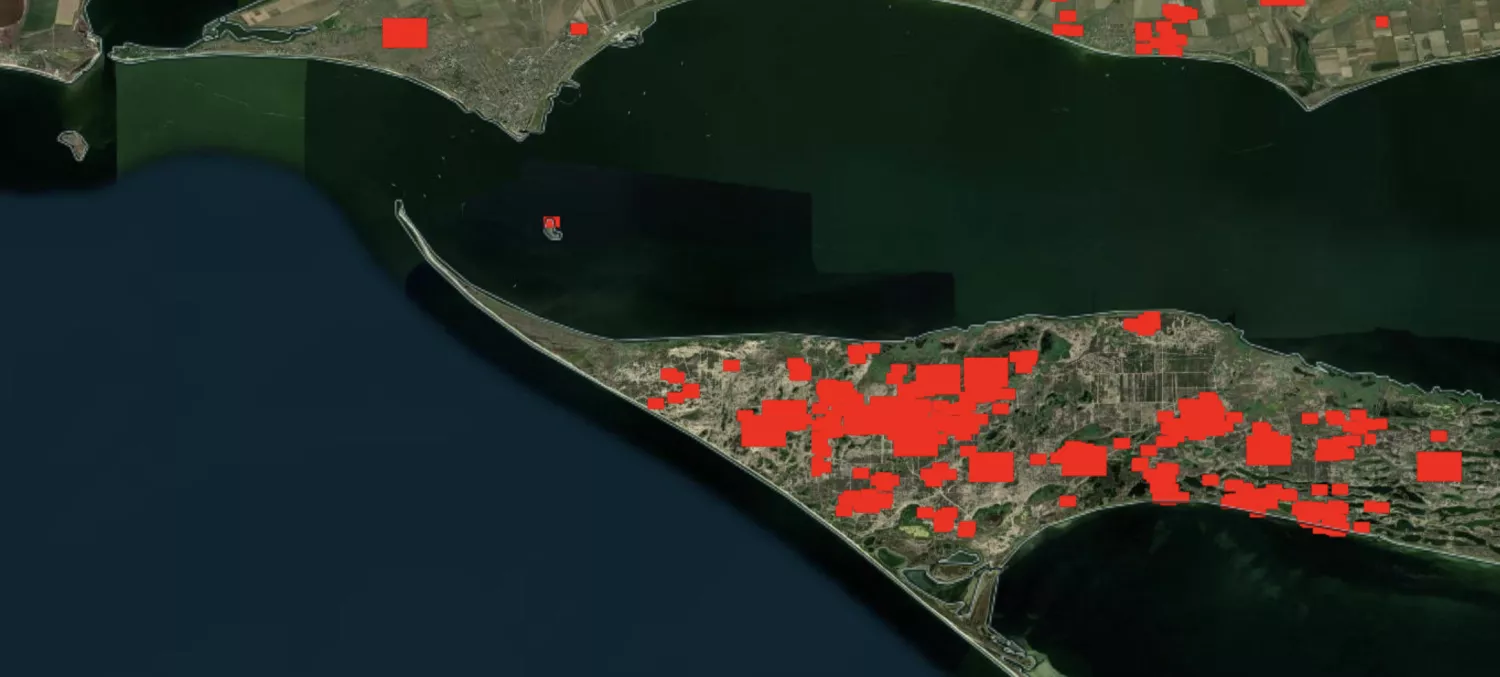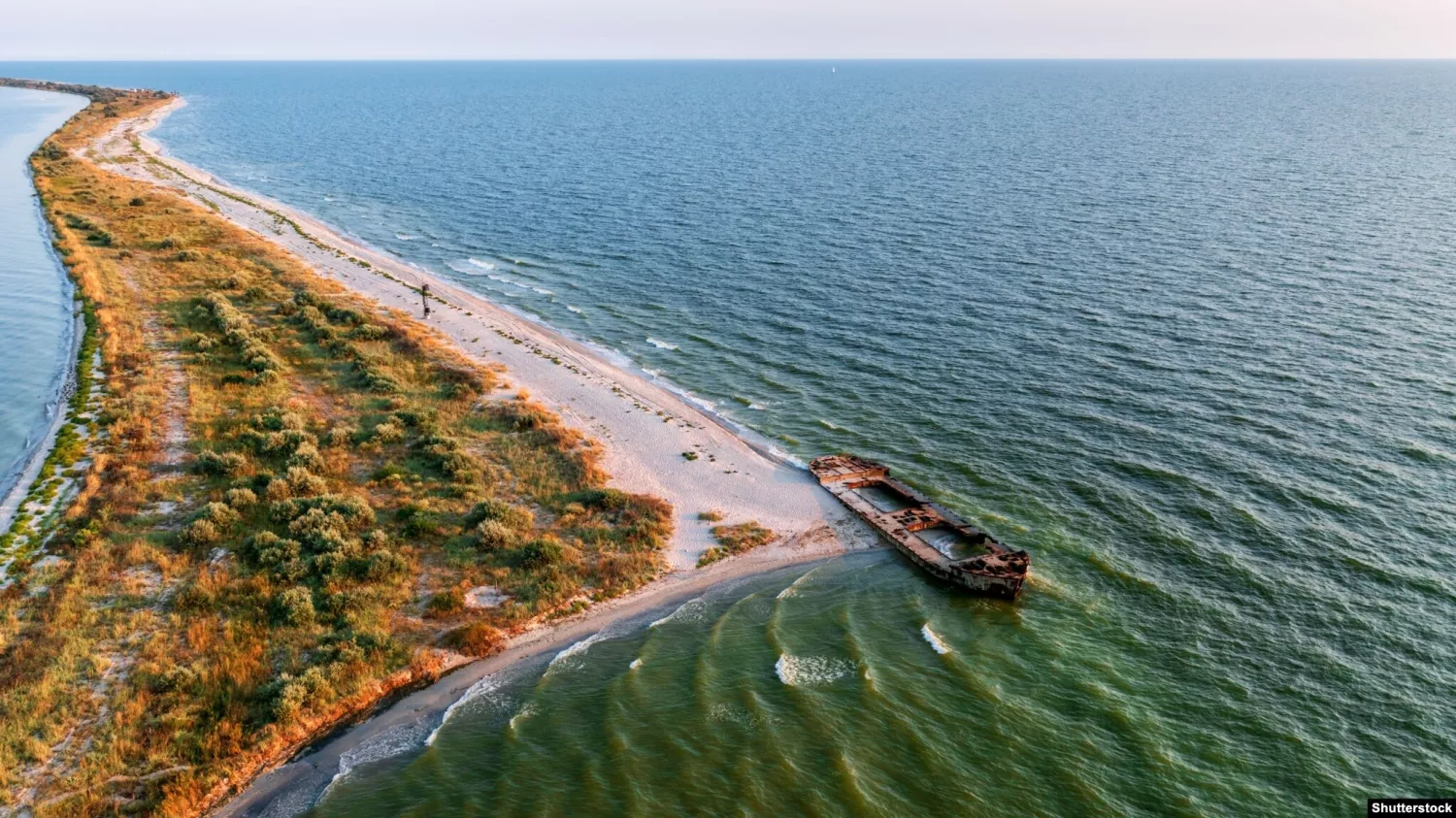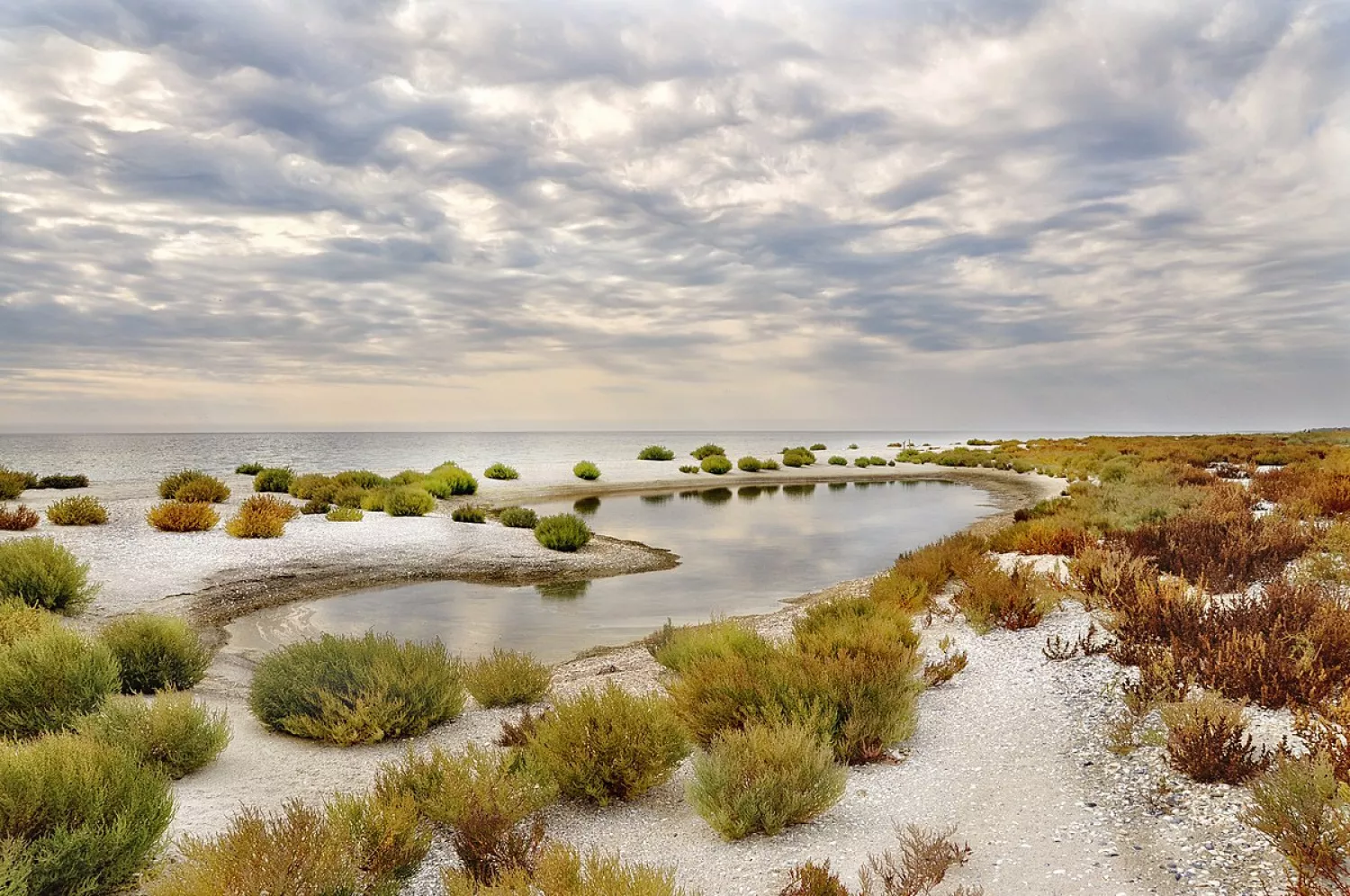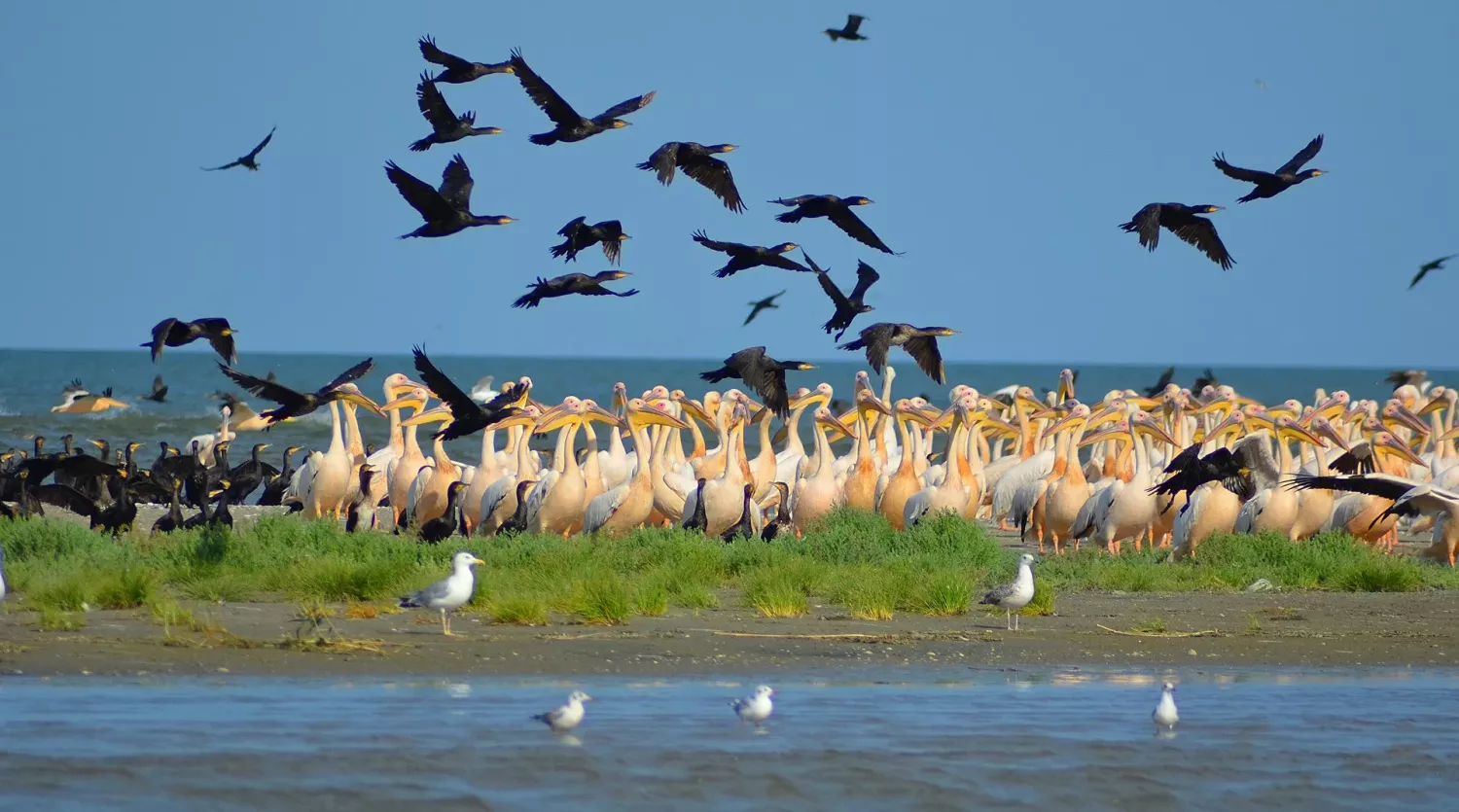«We need to leave nature alone». Does the Kinburn Nature Reserve have a chance for recovery?
- News of Mykolaiv
-
•
-

- Yuliia Boichenko
-
•
-
11:35, 17 September, 2025
More than three and a half years have passed since Russian troops seized the Kinburn Spit. Today, this protected area remains the only occupied part of the Mykolaiv region.
The Kinburn Spit is part of the National Nature Park «Biloberezhzhia Sviatoslava» and is a part of the UNESCO Black Sea Biosphere Reserve. Until recently, it was home to pine forests, pink pelicans, dozens of Red Book plants and a quiet sandy strip separating the sea and estuary. Today, it is an area of fires, minefields and fortifications left behind by Russian troops.
NikVesti decided to find out what awaits the Kinburn Spit after de-occupation, whether the protected area has a chance for recovery, and what solutions can help with this.
Hello! I am Yuliia Boichenko, the author of this article.
Thank you for your attention to our texts — it means a lot to the NikVesti team.
We regularly publish in-depth materials for those who want to understand the topic and get to the heart of the matter.
We have dozens of examples when our journalism, together with our readers, has influenced situations and changed them.
Join the NikVesti Readers’ Club — support independent journalism that matters.
Support us by joining the NikVesti Club
«Almost all of the territory has burned down». What is happening to Kinburn today?
Until 2022, Yevhen Kasianov went on expeditions and monitored the nature of the Kinburn Spit. For 12 years he has been working in the National Park «Biloberezhzhia Sviatoslava», now as a researcher in the research department.
«My colleagues and I used to go for one day, but there were times when we stayed there for several days. We described and registered rare species of plants and animals. It was a lot of work», Yevhen Kasianov recalls.
Now he continues to monitor the situation on the Kinburn Spit through satellite images. And Yevhen Kasianov himself is located near the protected area, with only an estuary separating them.
The war «has changed» the Kinburn Spit a lot, says Yevhen Kasianov, based on the results of his own official monitoring of the protected area.
«And we will be able to see exactly how much we will be able to see only after we get to this territory», the scientist added.
Due to military operations, fires periodically occur on the Kinburn Spit. In seven months of 2025, more than 400 fires broke out on the territory of the national park «Biloberezhzhia Sviatoslava» alone. This situation is further aggravated by heat and wind, which spread the fire over a larger area. For comparison, only 15 fires were recorded between 2012 and 2021.
 Scale of fires on the territory of the Kinburn Spit in August 2025, screenshot from NASA system «Modaps»
Scale of fires on the territory of the Kinburn Spit in August 2025, screenshot from NASA system «Modaps»The national park scientist said that the forests and fields on the Kinburn Spit have burned down almost completely.
«Today we can say that almost the entire territory of Kinburn has burned down, and most of the fires are of a repeated nature,» said Kasianov.
At the same time, the movements of Russian military equipment lead to the destruction of the protected area, says Oleh Derkach, Honoured Environmentalist of Ukraine, Head of the Mykolaiv Branch of the National Ecological Centre of Ukraine, Deputy Director of the National Nature Park «Kuialnytskyi».
«The chaotic movements of Russian military equipment lead to soil erosion, destruction of vegetation, and the dispersal of these sand arenas», he explained.
The conservationist says that the impact of the hostilities on the Kinburn Spit is significant — «the landscape there has completely changed».
«And in addition, we have craters from explosions, fortifications everywhere — they are there for a long time, for hundreds of years. For example, if we found their remnants from the Russian-Turkish wars, imagine how many of them will be there now. You will not recognise Kinburn», said Oleh Derkach.
At the same time, any hostilities lead to very heavy pollution of the territory with toxic substances, says Yevhen Kasianov, a national park employee.
«These are primarily heavy metal compounds: iron, manganese, lead, bismuth. It also includes very powerful pollution with lithium ions and compounds, which are very, very toxic. The source of such pollution is primarily all kinds of unmanned aerial vehicles», he explained.
Before the war, Kinburn was an important bird area — about 300 species of birds were there on their migration, nesting, and feeding, says conservationist Oleh Derkach.
«Daily explosions and fires are a factor of anxiety and fright for them. That's why we can't talk about nesting», he added.
According to Oleh Derkach, the Russian military organises hunting on the territory of the protected area.
«Of course, hunting used to be banned in protected areas. Now it's not just not banned, but the Russian military are randomly killing these animals. Anything that moves could be shot there.
Thousands of animals are also killed in forest and steppe fires. The biodiversity there is simply in a critical state», he said.
«The forest is lost». Why are experts against artificial reforestation of Kinburn?
In order to understand what will happen to the protected Kinburn Spit after the war, we need to know, at least in theory, how nature reacts and recovers in such conditions.
For example, the forests on the Kinburn Spit, which were created artificially, cannot be restored after fires, says ecologist Oleh Derkach.
«They will not recover on their own. Will it ever come to the point where we find the funds for such a restoration programme? Imagine that in the post-war period, there was a Stalinist plan to transform nature, there were resources, there were funds. In the 60s and 70s, Kinburn was especially intensively reforested — billions of hryvnias were spent. Will we have the resources to restore these forests? I think not soon. That's why we have definitely lost artificial forests», explained Oleh Derkach.
This opinion is also supported by Yevhen Kasianov, a researcher at the «Biloberezhzhia Sviatoslava». But he believes that some areas of Kinburn can still be reforested, but this should be done «very carefully» and not earlier than in 5-10 years.
«Then we will already have an idea of which areas are of greater conservation value and where there is a chance to introduce reforestation,» he explained.
Mykhailo Bohomaz, head of «Forests» at WWF, says that it makes no sense to return artificial forests, as «they will be completely unsuitable» in the face of climate change.
«It will be just burying money in the sand. In any scenario, it is absolutely futile and scientifically unnecessary.
The Kinburn Spit is primarily a steppe and marine ecosystem. And the natural forests that exist there will not disappear — they will regenerate themselves», explained Mykhailo Bohomaz.
Is the best solution to leave nature alone?
Starting the story about the restoration of the Kinburn Spit, ecologist Oleh Derkach says encouragingly: «These sand arenas are very peculiar, they have their own specific flora and fauna. Their potential for self-healing is very high».
The best solution for the restoration of the Kinburn Spit is not to interfere in this process and let nature do it on its own, he added.
«We need to give nature peace and time, it will recover. But, of course, if the hostilities stop. There are almost no people there. No one will return there quickly because of the mines. So I think that nature will quickly begin to recover», the ecologist suggests.
«It will take decades to restore the flora of the Kinburn Spit», says Oleh Derkach.
«This applies to natural forests, sandy steppe, and natural groves. I mean aspen, birch, oak groves, which are natural», he added.
For example, an orchid field is able to regenerate itself in a few years after fires, says Yevhen Kasianov, a national park employee.
«As a rule, for orchids, after a fire, a very large increase in both the number and abundance of orchids is observed within 4-6 years,» he said.
What are «biotechnical measures» and how can they help restore nature?
Biotechnical measures can help nature recover faster, says ecologist Oleh Derkach. Simply put, it is a process whereby humans help nature to accelerate its self-healing.
For the Kinburn Spit, this means, for example, creating artificial nesting places for birds.
«It is possible to create conditions that are safe for nesting birds with a high probability of hatching chicks and quickly restore the population of these birds. It is possible. Because, look, they nest in the rest of the territory, but there they are accessible to predators and trampled by cattle», the ecologist explained.
He gave an example of how, even before the full-scale war, the pink pelican was brought back with the help of biotechnical measures.
«We restored carp lakes on Kinburn, dug a strait and connected it to the Dnipro-Bug estuary. Fish began to enter the lakes, and when there was a lot of fish, bird colonies appeared there and pelicans began to fly there. Some of the pelicans, who were already feeling cramped on the Danube, flew here to us. That is, we created such artificial conditions for the reproduction of the pink pelican», explained Oleh Derkach.
The ecologist also mentioned the example of Odesa region, where Rewilding Ukraine specialists are now returning animals to the Tarutyne Steppe. The main rule in this case is to reintroduce only those species that used to live in this nature: fallow deer, kulan, hamsters, and marmots. It is assumed that the return of native animals to the area will help restore it.
«We are returning large animals that support the landscape. For example, in the 1990s, deer in the Danube Delta were almost completely wiped out, and this led to the catastrophic destruction of meadows. It turned out that meadows support large herbivores. And if there are no meadows, there are no birds that once lived there. There is a cascading effect. So now we are returning animals to the steppe and observing how their presence affects the steppe», says Mykhailo Nesterenko, Executive Director of Rewilding Ukraine.
But before implementing biotechnical measures, you need to understand the ultimate goal, emphasises ecologist Oleh Derkach. In the case of the Kinburn Spit, it is to help restore those areas that are natural and habitual for this protected area.
«We need to prioritise, for example, the restoration of wetlands, forest groves, natural steppe areas, sandy steppe areas, natural groves», says Oleh Derkach.
However, these solutions will only work after the territory is de-occupied and studied in detail, the ecologist says.
«Now we don't know exactly what is happening there. We all use satellite images, remote sensing methods to study the territory, but nothing can replace field research», added Oleh Derkach.
Are there any similar examples of restoration in the world?
Mozambique's experience: active recovery through international investment
The civil war in Mozambique, a country in southeastern Africa, lasted for almost 30 years. Poaching and warfare have devastated the ecosystem there. As a result, Gorongosa Park lost 90% of its large mammals, and the area was littered with unexploded ordnance.
The restoration of this area began only twelve years later. In 2004, the Government of Mozambique and the American Foundation Initiative «Carr Foundation» launched a joint project to restore the area. More than $100 million in donor funds were invested in the restoration.
This process took place in several stages:
- Reintroduction of animals, including buffaloes, elephants, zebras, hyenas, lions, wild dogs, and leopards. The population of large mammals has increased tenfold — from less than 10,000 to more than 100,000.
- Anti-poaching activities: training of rangers, reduction of poaching by 72%.
- Social programmes: the park employs more than 1800 people, finances schools, healthcare, supports travel agencies, coffee growing, and beekeeping. The park has built a Wilson Biolab for scientific research.
These measures have helped Gorongosa Park to become a biodiversity-rich area again, with lions, hyenas, wild dogs, and more.
Ecological restoration in Bosnia
Another example is the restoration of nature in Bosnia. After the war of 1992-1995, the country was one of the most heavily mined in Europe — more than 4,200 square kilometres of territory were dangerous because of mines.
After the war ended, the demining process began, funded by international donors. This allowed communities to regain access to forests, fields, tourism and agricultural resources.
 A mass grave on the cliffs of Mount Vlasic in Serbia, where a massacre took place in 1992. Photo: BIRN
A mass grave on the cliffs of Mount Vlasic in Serbia, where a massacre took place in 1992. Photo: BIRNInternational donors helped to restore the protected areas: The Global Environment Facility and the Food and Agriculture Organisation of the United Nations.
They planted trees, engaged local rangers, created ecotourism, and provided small grants to communities for entrepreneurship. They also implemented reforestation and degraded land restoration programmes, focusing on land use and community participation.
These actions helped restore forests and water systems and develop local ecotourism initiatives. As a result, economic and environmental security has been strengthened.
Of course, there are no other examples of protected areas restoration in the world that are identical to the Kinburn Spit. However, the small number of post-war nature restoration projects in other countries makes at least two things clear:
- such restoration is possible despite the differences in protected areas and their different geographical locations.
- international support, both financial and strategic, is crucial for post-war nature restoration, which will allow for the development of unique restoration programmes and the gradual restoration of these protected areas.
At present, it is difficult to say for sure how exactly the restoration of the Kinburn Spit will proceed. However, in this matter, we should rely on the opinion of experts who say that the best solution is to give the nature of the Kinburn Spit time to restore itself and enhance this effect with biotechnical measures. But this will only be possible after its de-occupation and at least partial demining.
At the same time, in order to restore the protected area, it is necessary to understand what animals and vegetation should be returned. Currently, the authorities do not pay much attention to this process, which is understandable given that the area is occupied and there is no access to it. However, in the future, there should be a document that clearly defines the plan for the restoration of the Kinburn reserve.
Yuliia Boychenko, NikVesti
The material was created with the support of the UNESCO International Programme for the Development of Communication. The designations employed and the presentation of the material contained in this publication do not imply the expression of any opinion whatsoever on the part of UNESCO concerning the legal status of any country, territory, city or area or of its authorities, or concerning the delimitation of its frontiers or boundaries. The views and opinions expressed in this publication are the sole responsibility of the authors. Their views and opinions do not necessarily reflect the official position of UNESCO and do not commit the Organization.
Чому ви читаєте «МикВісті»? Яка наша діяльність найбільш важлива для вас? Та чи хотіли б ви стати частиною спільноти читачів? Пройдіть опитування, це анонімно і займе 5 хвилин вашого часу








